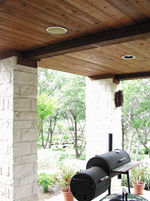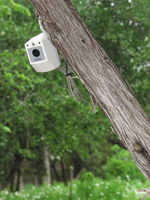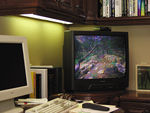In Tune with Nature Page 3
 Pick a Peck of Pickled Speakers
Pick a Peck of Pickled Speakers It used to be that, if you wanted outdoor sound, you either went industrial (long on durability but short on fidelity) or cheap (short on both). Fortunately, many mainstream speaker manufacturers have noticed a blossoming interest in outdoor sound and have grown quite a crop of outdoor offerings. Don't assume that, just because a particular company makes great indoor speakers, their outdoor varieties will be as good. Some companies, like Boston Acoustics (manufacturer of the excellent Voyager Series, $220 to $700 per pair), have spent a good deal of time and energy unearthing what makes a speaker sound good—and keep sounding good—outside. Other companies, however, see the category simply as a hole to fill on the dealer's shelf. So make sure you take a good, long listen before you buy. Above all, this is no place to go cheap. (Need I say that you get what you pay for?) I've seen "outdoor/indoor" speakers for as little as $35 per pair. I'd be hard-pressed to find a pair of headphones in that price range that I'd feel comfortable recommending, let alone speakers that will sit out in the sun, rain, and snow and be able to play at a decent volume in an unenclosed space without complaining.
 The most common type of outdoor speaker is the bookshelf-sized, on-the-wall type. You can mount this speaker on an exterior wall or, if you want to conceal it, mount it on a two-by-four or other post that's stuck into the ground and surrounded by foliage. With this type of speaker, look for a model that includes mounting hardware. Ported designs like Klipsch's SA Series ($429 to $699 per pair) and Russound's Outback ($220 to $420 per pair) are highly efficient—a much-desired quality in an outdoor speaker—but you'll have to keep the ports away from direct downpours (i.e., don't mount them pointing up). Sealed enclosures like Parasound's Outsider ($250 to $450 per pair) and Definitive Technology's AW100 ($399 per pair) are slightly less efficient but take direct water splashes with ease. In addition to their outdoor speakers, Niles Audio makes it easy to add outdoor sound yourself with their Music Anywhere Outdoor Speakers kit ($320 for the package), which includes a pair of on-wall OS3 speakers, mounting brackets, a wall-mount volume control with its own single-gang mounting bracket, and 100 feet of speaker cable. Niles includes a nice installation instruction manual, as well.
The most common type of outdoor speaker is the bookshelf-sized, on-the-wall type. You can mount this speaker on an exterior wall or, if you want to conceal it, mount it on a two-by-four or other post that's stuck into the ground and surrounded by foliage. With this type of speaker, look for a model that includes mounting hardware. Ported designs like Klipsch's SA Series ($429 to $699 per pair) and Russound's Outback ($220 to $420 per pair) are highly efficient—a much-desired quality in an outdoor speaker—but you'll have to keep the ports away from direct downpours (i.e., don't mount them pointing up). Sealed enclosures like Parasound's Outsider ($250 to $450 per pair) and Definitive Technology's AW100 ($399 per pair) are slightly less efficient but take direct water splashes with ease. In addition to their outdoor speakers, Niles Audio makes it easy to add outdoor sound yourself with their Music Anywhere Outdoor Speakers kit ($320 for the package), which includes a pair of on-wall OS3 speakers, mounting brackets, a wall-mount volume control with its own single-gang mounting bracket, and 100 feet of speaker cable. Niles includes a nice installation instruction manual, as well.
If you've got an exterior wall that's relatively protected from the elements, you can also use weather-resistant in-wall speakers. Don't just slap in a pair of regular in-wall speakers, though, because the changing outdoor conditions will soon have you back up on your ladder trying to discover why there's no music. Most of Phase Technology's CI Series in-wall speakers (starting at $360 per pair) are designed for outdoor as well as indoor use (or near damp environments like indoor pools and spas). Sonance also offers weather-resistant versions of most of their in-wall speakers (starting at $250 per pair).
 Several companies now offer stereo-input speakers that incorporate two tweeters and one or more woofers. For do-it-yourselfers, this type of speaker cuts the installation time in half, since one speaker handles both the left and right channels and you'll only need one four-conductor speaker wire. For larger areas, using multiple stereo-input speakers often makes it easier to balance the left and right channels throughout the listening area. Niles (OS10-SI, $280) and SpeakerCraft (WS940, $299; WS950, $399) were two of the first companies to offer this type of speaker, with Russound (Outback Solo, $249) recently joining the pack.
Several companies now offer stereo-input speakers that incorporate two tweeters and one or more woofers. For do-it-yourselfers, this type of speaker cuts the installation time in half, since one speaker handles both the left and right channels and you'll only need one four-conductor speaker wire. For larger areas, using multiple stereo-input speakers often makes it easier to balance the left and right channels throughout the listening area. Niles (OS10-SI, $280) and SpeakerCraft (WS940, $299; WS950, $399) were two of the first companies to offer this type of speaker, with Russound (Outback Solo, $249) recently joining the pack.
More in tune with nature are the two different types of rock speakers. The first is the dedicated rock, like the Rockustics Rocky III ($500 per pair) or the Stereostone Classic Stone ($230), each of which is a complete speaker on its own. Sonance takes a different approach: They make a special enclosure called the SoundHenge III ($200) that's designed to cover several of their Mariner on-wall outdoor speakers (starting at $279 per pair). The advantage is that you can use the same rock with different Mariner models so that you can choose how much you want to spend, as well as what quality of sound you want in a particular area.
 When you want to really pound some rocks, you need an outdoor subwoofer. Stereostone offers two models of aboveground subs, one of which—the Sunfire SubRock ($2,195)—conceals a Sunfire True Subwoofer inside a rock enclosure. In addition to the aboveground BP Sub ($3,600), Rockustics offers three models ($970 to $1,800) that let you bury the bulk of the subwoofer cabinet underground, leaving a much-smaller rock covering visible at the surface.
When you want to really pound some rocks, you need an outdoor subwoofer. Stereostone offers two models of aboveground subs, one of which—the Sunfire SubRock ($2,195)—conceals a Sunfire True Subwoofer inside a rock enclosure. In addition to the aboveground BP Sub ($3,600), Rockustics offers three models ($970 to $1,800) that let you bury the bulk of the subwoofer cabinet underground, leaving a much-smaller rock covering visible at the surface.
Of course, outdoor speakers also have their share of the exotic. For those of you who really want to cultivate an appreciation of music, Stereostone offers the Planter speaker ($199). Rockustics makes an entire line of planter speakers, ranging from the definitely domestic, 360-degree-dispersion Omni-Planter ($500 to $800 per pair) to the notably nutty CocoNutz hanging two-way planter speaker ($550 per pair). You can use Stereostone's Palos Verdes Stone in-wall speaker ($150 per pair) to wire stone fences and brick barbecues for sound.
T hen there's the Holy Grail of outdoor (and indoor) speakers: the wireless speaker. Fortunately for custom installers, wireless speakers still aren't ready for prime time—and that's before you consider their sound quality. Wireless speakers require a built-in amplifier, and that electricity needs to come from somewhere. Usually, that means batteries (and plenty of them) or an AC power cord (which kind of ruins the wireless aspect). Of course, if there's simply no way to get speaker wire to your outdoor-speaker location, this may be the only way to go.
hen there's the Holy Grail of outdoor (and indoor) speakers: the wireless speaker. Fortunately for custom installers, wireless speakers still aren't ready for prime time—and that's before you consider their sound quality. Wireless speakers require a built-in amplifier, and that electricity needs to come from somewhere. Usually, that means batteries (and plenty of them) or an AC power cord (which kind of ruins the wireless aspect). Of course, if there's simply no way to get speaker wire to your outdoor-speaker location, this may be the only way to go.





























































